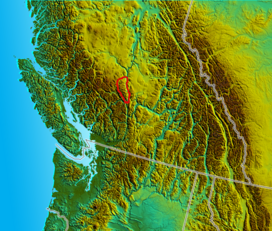Camelsfoot Range
| Camelsfoot Range | |
|---|---|
| Highest point | |
| Peak | Red Mountain |
| Elevation | 2,445 m (8,022 ft) |
| Coordinates | 51°12′13.0″N 122°32′55.0″W / 51.203611°N 122.548611°WCoordinates: 51°12′13.0″N 122°32′55.0″W / 51.203611°N 122.548611°W |
| Dimensions | |
| Area | 2,390 km2 (920 sq mi) |
| Geography | |
| Country | Canada |
| Province | British Columbia |
| Parent range | Chilcotin Ranges |
The Camelsfoot Range is a sub-range of the Chilcotin Ranges subdivision of the Pacific Ranges of the Coast Mountains in British Columbia.* The range is c. 90 km at its maximum length and less than 30 km wide at its widest.
The far southeast end of the Camelsfoot is extremely rugged, and dropping to one last point at 7000'-plus before plunging into the gorge of the Fraser Canyon at Fountain, near Lillooet. For 45 km NW from there, the range is rocky and lightly forested with lodgepole pine, breaking into high benchlands and large creek basins draining through benchland country via small canyons.
Beyond that the range's terrain is much more gentle, with high, meadowed ridges running east towards the Fraser Canyon between treed plateaus and small canyons, and a few large, barren domes running further north along the Fraser. The range is bounded on the north and west by a large and impressive benchland-and-hoodoo sand canyon similar to those along the range's east flank - that of Churn Creek, which is a provincial protected area. The historic Empire Valley Ranch is near the mouth of Churn Creek and is provincially protected for heritage and environmental reasons. It is on a high side-valley above the Fraser Canyon; north of it beyond Churn Creek is the historically significant Gang Ranch.
Camelsfoot Peak and the range itself take their name from an odd episode in the story of the Fraser and Cariboo Gold Rushes. Frank Laumeister, a United States veteran of the Camel Corps, bought 23 camels from the US military, which was ending their use. He used the animals to carry freight on the Douglas Road and the Old Cariboo Road from Lillooet to Fort Alexandria, and later on the new Cariboo Wagon Road from Yale. After this, he finally discontinued using the camels. Horses could not stand their smell, the camels' soft feet were hurt by the rocky soils of the BC Interior and the canyon trails, and handlers found them difficult. Many escaped retirement into the wilds.
...
Wikipedia

